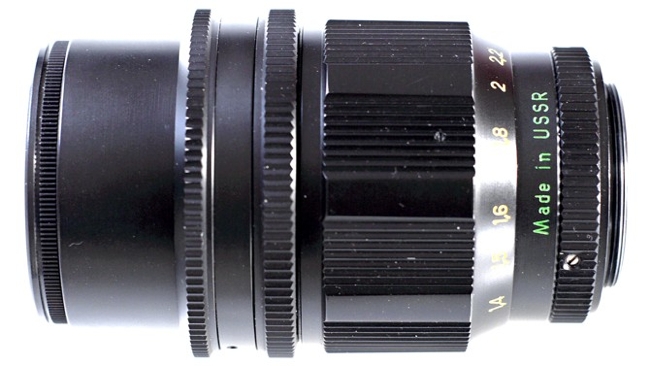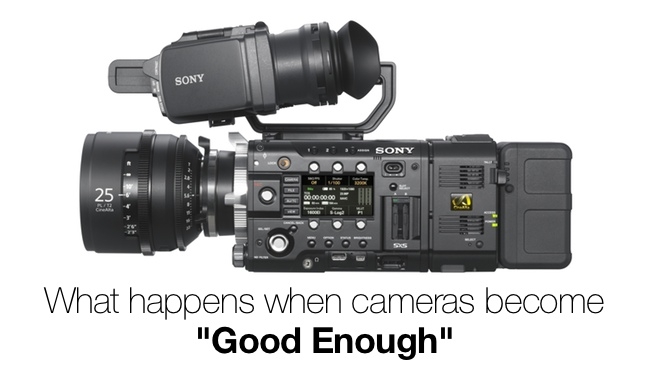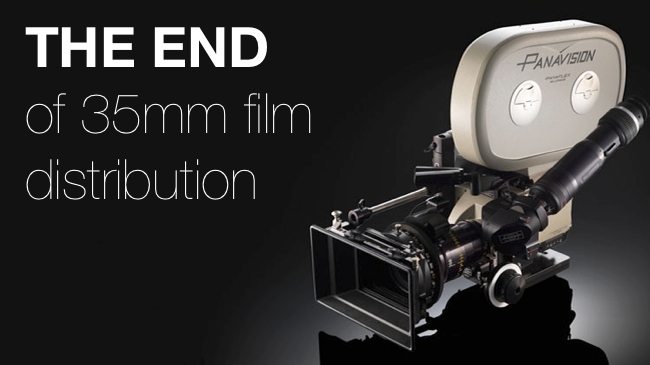
 Best of Phil Rhodes 2014
Best of Phil Rhodes 2014
RedShark News Technical Editor Phil Rhodes has had an extremely busy 2014. We dive into our archives and unearth his best articles of the past year, including how-to's, guides, opinion, reviews and conversations with Hollywood professionals.
It's been a year chock full of news relevant to filmmakers and film professionals. And through the rush of 4K camera releases, surprise announcements and emerging technologies that may redefine the cinematic experience, RedShark News' resident technologist, Phil Rhodes, has been our bellwether. His insightful reviews and analysis, informative 'how-to' guides, provocative opinions and engaging profiles of professionals involved in all aspects of professional filmmaking make him a guiding force for our readers and everyone here at RedShark News.
It's that time of year when it's only natural to look back and take stock of what we've done and accomplished. With that in mind, we look back on Phil's contributions to RedShark News in 2014. We think he's one of the very best film tech writers working today
How-to's
Besides being our go-to guy when it comes to technology, Phil Rhodes is also a working cinematographer, which partly explains his voluminous knowledge when it comes camera and production.
While 4K cameras are becoming increasingly ubiquitous in all scales of production, 4K display adoption has lagged behind, meaning that broadcast delivery continues to be, for the most part, a high-definition affair. Some may think that HD capture is perfectly fine for HD delivery, and in many cases, they're probably right. And it may seem downright impractical or, at least, counter-intuitive to shoot at a much higher resolution than what your delivery specifications require. But there are real, undeniable benefits to shooting in 4K for HD delivery. Phil got into the technical nitty-gritty of why this is the case and offers valuable advice in:
Next, here are two articles which should be of particular interest to Canon DSLR shooters. For those out their still getting great use out of their trusty Canon 5 or 7Ds, you may have run into the problem of a very noticeable (and likely unwanted) contrast shift when viewing the footage in some NLEs or on some monitors. There are reasons for this behavior and steps you can take to compensate for the effect:
Additionally, Canon shooters should be interested in what exactly that Technicolor Cinestyle is doing to your footage. Actually, any shooter who captures video using a flat or 'log' picture style (and even editors that have to deal with said footage) at all levels of filmmaking will be pleased to find important information and guidance here:
Next, we have an article that's less of a how to and more of a how to avoid. Many shooters that started with DSLRs were drawn to that form factor as an alternative to fixed lens models. Part of the appeal was the ease with which, with the use of adapters, you could slap almost any piece of glass on these cameras that suddenly had the capability to shoot video that rivaled that of more expensive cameras. Win-win, right?

Sure, all that experimentation of using old, photography lenses from the 1970s and stacking five filters was fun, but when shooting in 4K, the hit you're taking in resolving power by using less-than-great glass or too many filters will be more noticeable than when shooting in HD. Phil goes into much greater detail here:
Finally, we have one for those who prefer to imagine a world in grayscale. Many existing tools for converting colour video footage into black-and-white do an acceptable job, but there is a utility that Phil believes produces results close to a true monochromatic image (that is, as long as you start from a RAW file). Check out the following article for more info:
Keep reading for very thorough explanations of film tech, opinions on the state of production and cinema and much more!
Film Tech Explanations
Camera
For beginning cinematographers (and even for professional shooters who would benefit from a refresher), Phil covered commonly misunderstood aspects of the craft throughout 2014.
These days (and now more than ever), cinematographers must be knowledgeable in shooting with all manner of cameras, from DSLRs to ENGs to the cameras built like tanks, from micro four thirds to full frame and beyond. There are endless production pitfalls for those that don't take into account and respect the important differences between cameras, sensors and lenses and what they mean to day-to-day shooting. These articles from Phil should be of great help:
- All About Sensors, Lenses, and Depth of Field Part 1
- All About Sensors, Lenses, and Depth of Field Part 2
- Misunderstanding Crop Factors
- Understanding ISO in Digital Cameras: It's not what you think
Lighting

It's perhaps in the category of lighting that Phil's fascination with technology is most apparent, as he is seemingly always on the lookout for the next innovation. At times, that quest for the new takes him to the gates of Warner UK Studios and, at other times, it takes him to the laboratory to explore the relationship between quantum physics and lighting:
- New Lighting Technology Shown at Warner UK Studios
- Better Lighting With Quantum Dots
- A Better Way to Produce White Light from LEDs
Of course, it's great to be up on lighting at the experimental level, but for day-to-day shooters, it's arguably more important to know about the lights that they are likely to find on set right now. Don't worry; Phil has you covered here, too, whether extolling the virtues of an old Hollywood favorite or breaking down the quality and character of practical lights that find their way onto lower budget productions:
- Despite All the New Developments in Lighting, HMIs Still Have A Lot Going for Them
- Practical Lighting Colorimetry (or can I light a scene with this lamp?)
Colour

In the film word, the subject of 'colour' is much bigger than the singular role of the colourist; in fact, colour is a huge consideration across the board, from directors and cinematographers to costume and art to editors and visual effects artists, through delivery to screens and display systems of wildly varying specifications. Over the past year, Phil addressed 'colour' in a short collection of articles that cover history, practical application and a lesson in colour that would be of great benefit to all:
- The Early Quest for Colour
- The Art of Colour Rendering
- All You Need to Know About Digital Blur
- This May Be the Most Important Lesson About Colour You Ever See
Distribution
So, you're prepping your first production that you know will be exhibited on a screen significantly larger than your 22" computer monitor. Well, there's a process that must be undertaken if you're film is good enough (and lucky enough) to be selected for most film festivals and for wide theatrical distribution. Plus, if your film is being shown in 3D, it might be worth investigating what projection system is in play, as Phil elaborates in the following articles:
- DCP: Digital cinema package explained
- Laser Projectors: Here's how they work and why they're especially good for 3D
And most importantly...

To round out the 'film tech explanations' portion of our Phil Rhodes bonanza, here's a bit of timely advice that will keep your film production from becoming a film tragedy:
Keep reading for opinion pieces, equipment reviews and conversations with top Hollywood editors!
Opinion & Reviews
Production

Throughout 2014, Phil weighed in on several hot topics of our industry, especially as they pertain to cameras and production. Phil's deeply analytical approach produces thoughtful and illuminating opinion pieces that balance evaluations of the present with a probing the possibility of our uncertain future. Here's a sampling of his best production op/eds from the previous 12 months:
- The Cinematic Debate: When are three chips better than one?
- Opinion: Should we be using low contrast camera modes to make our video look like film?
- Opinion: Watch out for dubious LED claims
- Opinion: Camera ergonomics - which is better, ENG or film-style?
- What Happens When Cameras Are Good Enough: An alternate take
- Opinion: Will all cameras eventually have to have global shutters?
Technology

In his unofficial role as RedShark News' Chief Technologist, it's Phil's duty to lend his thoughts broadly on technology and how its use and development impacts filmmaking and the professional film community in general. In this next series of articles, Phil explores whether we're suffering from technology overload, what the implications are of our continual push for higher and higher "quality," how video games and films are merging, and why the end of 35mm film distribution in cinema houses may be a good thing:
- Too much technology?
- Opinion: Cameras and post-production can work now at unimaginably high quality. But do we need it and do we want it?
- Are Films Turning Into Video Games?
- The End of 35mm Film Distribution: Cinema will never be the same (it will actually be better)
Business
Although its not his primary field of interest, Phil delved into the business-side of filmmaking, with common sense advice for those thinking of a formal film education and beginners who might be tempted to join a crew for only meals and credit:
Reviews

Often, when a hot new camera or piece of equipment is released (or finds its way to our offices pre-release), we grab Phil to review the product. In 2014, this meant three Sony cameras, one Canon and a DSLR rig from Walimex. As always, Phil left his technologist hat on and delivered extraordinarily in-depth reviews that squarely place these models in their proper technical and practical contexts:
- The Biggest Challenge Yet to the 5D: We review the Sony Alpha 7s
- New Sony x70: A 20 megapixel 4K XDCam - Our first hands-on
- Redshark Reviews: Walimex Aptaris DSLR Rig
- RedShark Reviews: Sony's PXW-X180 examinedRedShark Reviews: Sony's PXW-X180 examined
- RedShark Reviews: Canon XF205
Keep reading for crew profiles and conversations with top Hollywood editors!
Crew Profiles and Conversations with Hollywood Editors
Crew Profiles
Have you ever wondered what it's life to be a Steadicam operator or camera assistant of big budget Hollywood productions? Perhaps not, but the following articles shine a light on not only the individual jobs of these professionals, but also the lifestyle and goings-on of filmmaking at the highest levels:
Conversations with Editors

And finally, we close this our end-of-the-year foray into the Phil Rhodes archives with a little bit of Tinseltown razzle-dazzle. In 2014, Phil Rhodes sat down with two of Hollywood's most talented and sought-after editors, William Goldenberg (Argo, Zero Dark Thirty, Transformers) and Dody Dorn (Fury, Memento, End of Watch), a revealed a glimpse of editing at blockbuster scale and on top Indie-style productions:
- Editing Fury
- William Goldenberg Talks to RedShark About Editing the Alan Turing Biopic The Imitation Game

And that wraps up the Best of Phil Rhodes 2014! We hope you found this foray into the Phil Rhodes archives to be entertaining, informative and of benefit to you, whatever your specific area of expertise or interest may be. Be sure to visit RedShark News daily and in the coming year for more from Phil and other news and opinion for film professionals!
Tags: Technology


Comments